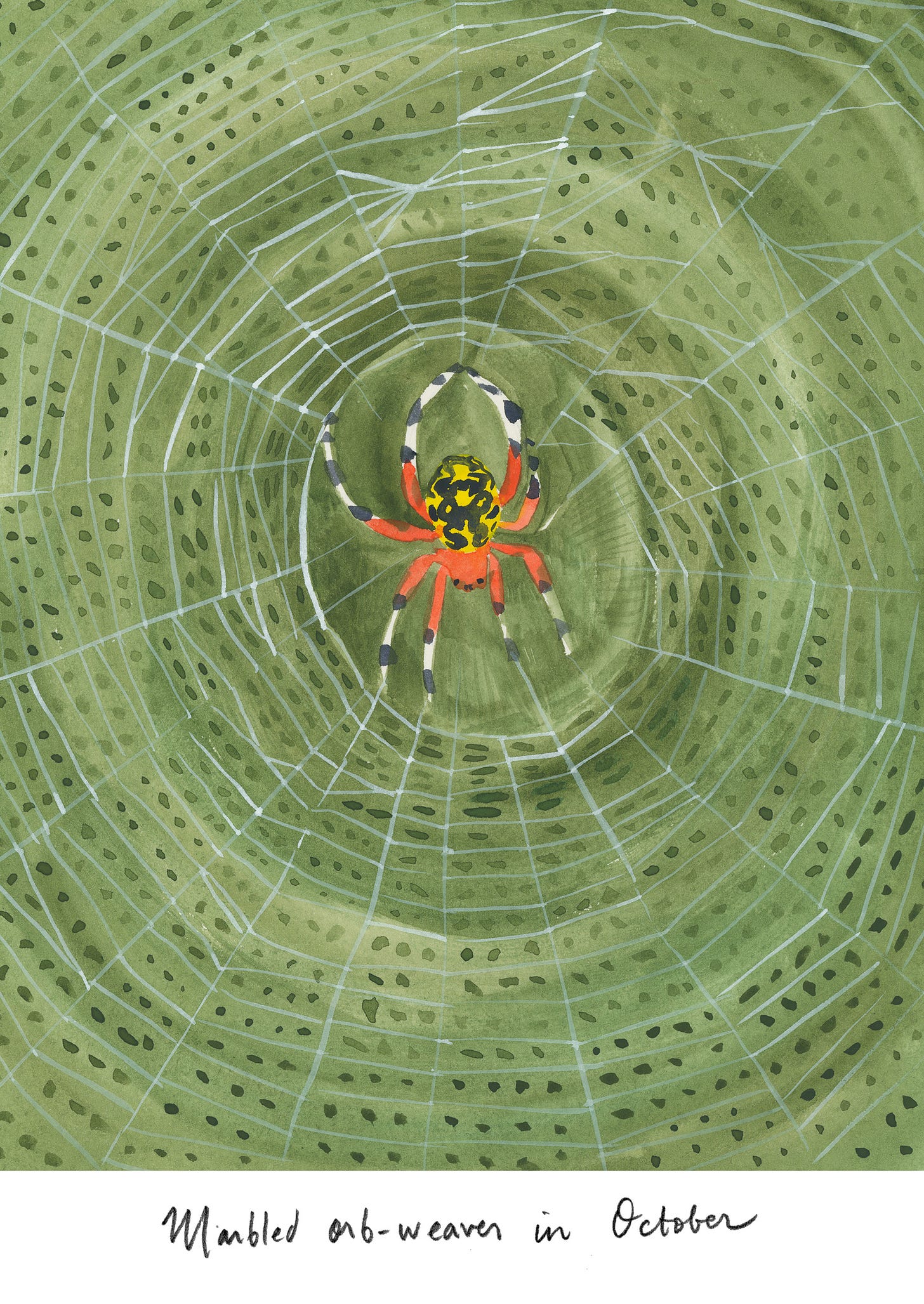Wild Life / marbled orb-weaver
running into webs
Hi, friends — welcome to new readers! This is issue #32 of my newsletter about animal encounters. We had one stunning week of sunshine here in Connecticut, the best weather of the year. All of us were out and about, making up for lost time: chipmunks scurrying, geese flocking, kids running on fields. Meanwhile, the plants are powering down and changing hues, retreating underground. Every living thing feels the shift, both harvest and reckoning, and away we go into the dark. At night the marbled orb-weavers (Araneus marmoreus) come out and make their giant masterpieces. — Amy Jean
This time of year I realize we’re here by the grace of spiders. They’re in every corner, watching with tiny eyes, wrapping the world in silk. I visited a friend one morning at their house in the woods and nearly walked into a five-foot web. I only stopped because I saw the poor spider floating above the path (the web was nearly invisible). I had no answer to the riddle, no secret password, only a stick to move the spider’s main anchor line gently to the side.
I did once walk into a five-foot web, a terrible experience for both the spider and me. The web was the handiwork of a marbled orb-weaver, a big, brightly colored spider with impressive patterning. It looks alarming and possibly deadly, but it’s actually a harmless garden spider with a prodigious work ethic.
Orb-weavers are common—there are around 1,500 species around the globe. And yet it’s a surprise to see a marbled orb-weaver, as they’d rather be hiding during the day. They are active at night, fashioning their webs, hanging tight, minding a signal line for vibrations. They swiftly catch and wrap prey like a sandwich at a good deli.
Males are pretty much gone by now, having accomplished their main task in life, to mate (a related species has a courtship process in which the male spins a mating thread across the female’s web and basically strums it for her—I love this).
Females tend to be out in October, tending their webs and getting ready to lay eggs. Once she makes her little egg-sac bundle, carefully crafted and tucked away somewhere safe, she slowly winds down and dies. In spring, the spiderlings will hatch, and then cast a thread to the wind, ballooning their way forward to a new home, like dandelion seeds.
Something about this life-cycle fills me with an intense sadness. The orb-weavers make and remake their web masterpieces over and over again, spinning in circles, through the vast, seemingly endless days of summer. And then, one day, a last web is made. When I look out the window at breakfast, sometimes I catch sight of a leftover bit of silk, an anchor unmoored, glinting in the morning light.
Marbled orb weaver links—
What’s it like to make your own silk and have eight legs? Here’s a very close-up look at an orb weaver making her web—it’s pretty incredible footage, and there’s 14 mins to put on in the background of whatever you’re working on. [YouTube]
Bugguide.net is a super handy resource in general, and for the orb-weavers it gives a sense of the many variations in color and patterning—you’ll understand why one is also known as the “pumpkin spider” [bugguide.net]
Wistful footage of other spider species “ballooning”—just really super cool [National Geographic via YouTube]
Animal encounters in recent comments—
Butterflying over to Edith Zimmerman’s newsletter, where she has a lovely couple of posts about a monarch caterpillar.
Also—
Years ago, thanks to Matt Moses and Hic & Hoc, and Guy Pettit and Flying Object (hi, guys!), I made a comic book called “Spider, Man,” about a man and a spider on the anti-social web. The cover is a letterpress web :) I have a few extra copies that I’m putting up for sale, here.
Lil’ spider drawing above is also for sale; part of the proceeds will go to the American Arachnological Society. (Apparently we know very little about spiders and how they’re faring! Turn a thoughtful glance in their direction, even the ones in your sink; they need our help.)
Wild Life #32 / this newsletter is a place to learn about the life around us, one silken thread at a time. I do this because I’m not sure what to do about the millions of species in danger of extinction. It means something to see and learn about and enjoy the life around us. Thank you for subscribing—I’m glad you’re here!



I, too, am a fan of your newsletter, with its sweet paintings and informative, wonderfully written essays. Thank you so much!
YOUR MOST BEAUTIFUL ESSAY EVER!!! Thank you, Amy Jean Porter!